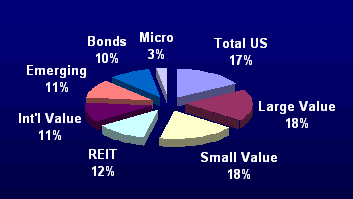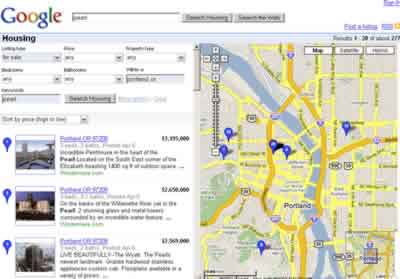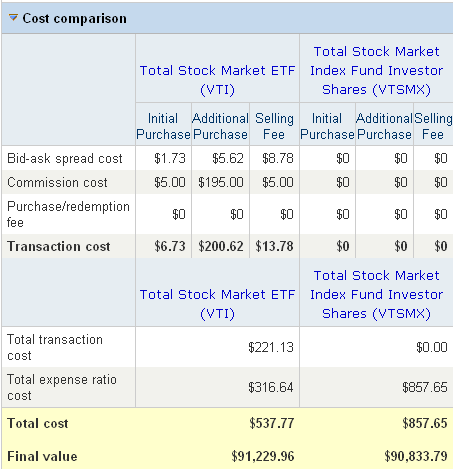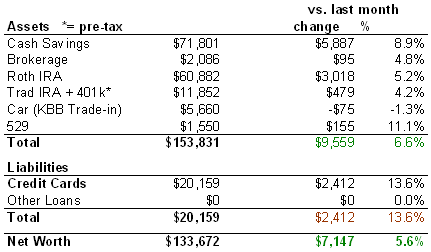It’s time for another bi-monthly update on my investment portfolio.

| Retirement Portfolio | ||
| Fund | $ | % |
| FSTMX – Fidelity Total Stock Market Index Fund | $12,599 | 17% |
| VIVAX – Vanguard [Large-Cap] Value Index | $14,082 | 18% |
| VISVX – V. Small-Cap Value Index | $14,146 | 18% |
| VGSIX – V. REIT Index | $9,229 | 12% |
| VTRIX – V. International Value | $8,294 | 11% |
| VEIEX – V. Emerging Markets Stock Index | $8,040 | 11% |
| VFICX – V. Int-Term Investment-Grade Bond | $7,726 | 10% |
| BRSIX – Bridgeway Ultra-Small Market | $2,086 | 3% |
| Cash | none | – |
| Total | $76,202 |
| Fund Transactions Since Last Update |
| Bought $1,500 of FSTMX on 4/5/07 (36.773 shares) |
Thoughts
Not much going on, I have been contributing a $500 a month to my Solo 401k while trying to build up my cash hoard for a house downpayment. I still plan on tweaking my asset allocation, but I’ve just been distracted by other things and kind of want to wait a full year before making any changes.
All of our Vanguard funds are held at Vanguard.com, where there are no commissions for trading their mutual funds. Currently, everything there is in Roth IRAs, one each for my wife and I. Even though Roth IRAs rock, we haven’t contributed to one this year yet because we might be over the income limits for 2007.
The Fidelity fund is also held in-house at Fidelity, where I have my Self-Employed 401k. Funds are also no transaction fee (NTF) there. It’s a bit annoying that both their Spartan Total US and International funds have high $10,000 minimums, but the 0.10% expense ratio is nice. I could also trade ETFs, but at $20 a trade it’s a bit expensive.
You can see some older posts on how this portfolio came to be here, as well as my previous portfolio snapshots here.



 It will be very rare that you will be kicked out of your home. As someone who has been unceremoniously given 30 days notice to leave a rental that they enjoy, I look forward to a day when I don’t have to worry about frantically searching for another rental or hiring a moving company. As long as I avoid any future freeway developments I should be able to find a home I can live in for as long as I want.
It will be very rare that you will be kicked out of your home. As someone who has been unceremoniously given 30 days notice to leave a rental that they enjoy, I look forward to a day when I don’t have to worry about frantically searching for another rental or hiring a moving company. As long as I avoid any future freeway developments I should be able to find a home I can live in for as long as I want.

 The Best Credit Card Bonus Offers – March 2024
The Best Credit Card Bonus Offers – March 2024 Big List of Free Stocks from Brokerage Apps
Big List of Free Stocks from Brokerage Apps Best Interest Rates on Cash - March 2024
Best Interest Rates on Cash - March 2024 Free Credit Scores x 3 + Free Credit Monitoring
Free Credit Scores x 3 + Free Credit Monitoring Best No Fee 0% APR Balance Transfer Offers
Best No Fee 0% APR Balance Transfer Offers Little-Known Cellular Data Plans That Can Save Big Money
Little-Known Cellular Data Plans That Can Save Big Money How To Haggle Your Cable or Direct TV Bill
How To Haggle Your Cable or Direct TV Bill Big List of Free Consumer Data Reports (Credit, Rent, Work)
Big List of Free Consumer Data Reports (Credit, Rent, Work)